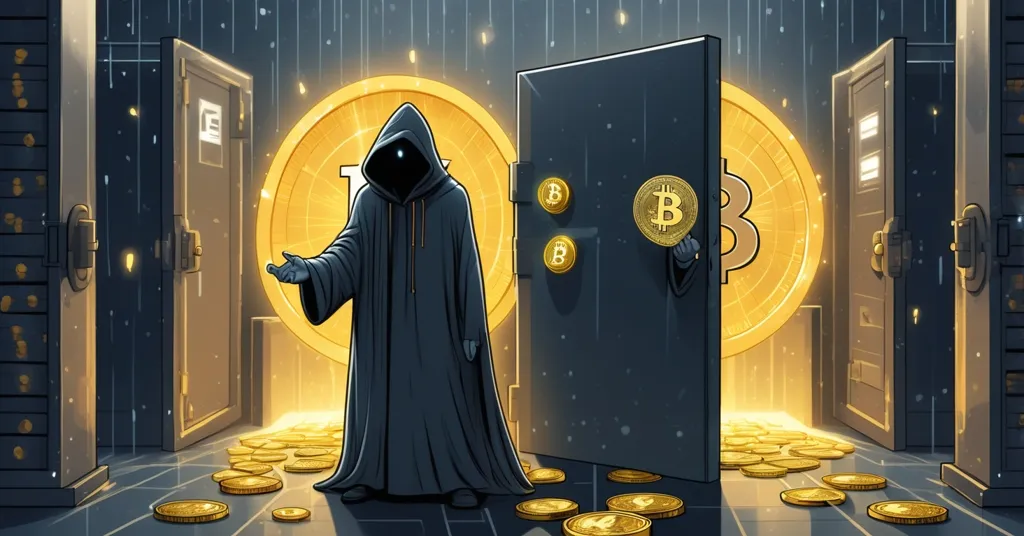Davinci Jeremie’s Bitcoin Call Sparks Debate as $8.6B BTC Mystery Unfolds

Davinci Jeremie’s Bitcoin Wisdom Ignites Debate Amid $8.6B BTC Transfer Mystery
Bitcoin pioneer Davinci Jeremie, who snapped up BTC at a mere $1 over a decade ago, has unleashed a viral message to new investors: embrace the doubt, stack your sats, and secure your future. His words land at a moment of high intrigue, as a staggering $8.6 billion worth of Bitcoin—80,000 BTC—recently moved from wallets dormant since 2011, stirring wild speculation about early crypto titans and market impacts. This collision of inspiration and mystery offers both a rallying cry and a reality check for anyone eyeing the crypto space.
- Jeremie’s Bold Advice: Urges newcomers to “stack sats” during market skepticism for massive long-term rewards.
- Historic BTC Movement: 80,000 BTC, now worth $8.6 billion, shifted from 2011 wallets, sparking theories about early giants.
- Bitcoin’s Unique Strength: Jeremie touts BTC as a stable inflation hedge, far safer than the volatile altcoin gamble.
Jeremie’s Battle Cry: Stack Sats and Become a Legend
Davinci Jeremie isn’t just another crypto commentator—he’s a walking proof of Bitcoin’s life-changing potential. Having bought in when BTC was practically loose change, his advocacy spans over a decade, marked by consistent calls to believe in the world’s first cryptocurrency even when the world scoffed. His latest message, spreading like wildfire across social media, cuts straight to the bone: don’t let fear or doubt stop you. “Stacking sats in times of disbelief makes you legend later,” he proclaimed, a direct challenge to new investors wavering in today’s choppy market. For those new to the game, “stacking sats” means grabbing small fractions of Bitcoin—called satoshis, where 1 BTC equals 100 million of them. It’s a slow-and-steady approach, perfect for anyone with just a few bucks to spare, especially when the crowd is shouting “bubble” or “scam.” You can explore more about his philosophy on his social media presence.
“Those who stacked when nobody believed… will live like legends when everybody else regrets.”
Jeremie’s words carry weight because he’s lived the journey. Bitcoin, born in 2009 as a radical decentralized currency, hovered at $1 in 2011, soared to $20,000 by 2017, and smashed past $60,000 in 2021. Those who held through the naysayers and crashes didn’t just profit—they rewrote their futures. His advice isn’t about chasing overnight riches; it’s a gritty reminder that Bitcoin rewards patience over panic. But let’s not sugarcoat it: not everyone has the stomach for the wild swings. Some who stacked sats in past dips still sold too early, missing the peaks. Jeremie’s gospel of conviction sounds inspiring, but it demands nerves of steel—something every newbie should weigh before diving in. Community discussions on platforms like Reddit highlight his long-standing advice on this strategy.
Bitcoin vs. Altcoins: A Maximalist’s Sharp Take
Jeremie doesn’t hold back when comparing Bitcoin to the thousands of altcoins—alternative cryptocurrencies—that flood the market. He calls BTC “the one asset that offers long-term peace of mind,” a digital fortress against inflation and global chaos, while casting altcoins as a risky casino. With Bitcoin commanding roughly 50% of the total crypto market cap, often dubbed “digital gold” for its relative stability, Jeremie’s maximalist leanings aren’t baseless. Many altcoins are a cesspool of broken dreams and outright theft—think “rug pulls,” where developers hype a project, pocket investor funds, and vanish, leaving holders with worthless tokens. The graveyard of failed altcoins is vast, and the horror stories of burned investors are endless.
That said, fairness demands a counterpoint. Altcoins aren’t all scams; some carve out vital niches Bitcoin doesn’t touch. Ethereum, for instance, powers decentralized finance (DeFi) with smart contracts—self-executing agreements that cut out middlemen—fueling billions in lending and trading. Privacy coins like Monero offer anonymity that Bitcoin, with its public ledger, can’t match. Jeremie’s dismissal of altcoins as a whole might oversimplify a complex landscape. Bitcoin doesn’t need to be everything to everyone, and these other projects can drive innovation in ways BTC shouldn’t. Still, for long-term security, his argument holds: Bitcoin’s track record and network strength make it the safest harbor in a stormy crypto sea. New investors, beware—chasing altcoin hype often ends in tears.
$8.6 Billion Bitcoin Mystery: Ancient Wallets Come Alive
As Jeremie’s message galvanized the community, a bombshell dropped: 80,000 BTC, bought for a laughable $80,000 in 2011, now valued at $8.6 billion, moved from eight wallets—each holding 10,000 BTC—that hadn’t stirred in over a decade. Detected on a recent Friday, this transfer sent Bitcoin analysts into a frenzy. Who’s behind it? Why now? Theories range from plausible to outright tinfoil hat. Some point to Ripple co-founder Arthur Britto, whose cryptic emoji post last month—after 14 years of online silence—raised eyebrows. Others name Roger Ver, a veteran Bitcoin supporter with deep ties to the early days. Coinbase’s Conor Grogan offered a grimmer take, suggesting this could be a compromised stash from an original holder, a stark warning about security even for crypto OGs. For deeper insights, check this analysis on the massive transfer.
The speculation doesn’t stop there. Whispers link these wallets to Bitcoin’s elusive creator, Satoshi Nakamoto, whose own holdings could top $100 billion if still accessible. Community chatter on platforms like X has spun into full conspiracy mode, with XRP enthusiasts floating Britto or Ripple’s David Schwartz as potential Satoshi candidates—though Schwartz has flatly denied it. Beyond the “who,” the “why” adds another layer: Forbes notes the BTC was shifted to new wallets using modern address formats, likely to guard against future risks like quantum computing attacks. For the unversed, quantum computing is a theoretical threat where ultra-powerful machines could crack Bitcoin’s encryption, exposing old-style addresses. This move signals not just wealth, but foresight—a chess play against tomorrow’s dangers. More on these ownership speculations can be found here.
Let’s zoom out for context. Large wallet movements aren’t new; past examples like Mt. Gox’s transfers—tied to the infamous 2014 hack—have rattled markets, sometimes triggering sell-off fears or, conversely, FOMO-fueled rallies. This $8.6 billion shift could sway sentiment either way. If the owner dumps even a fraction, prices might tank. If they hold, it could reignite awe at Bitcoin’s early success. Unlike a billionaire shifting cash to a new bank, where ripples are contained, Bitcoin’s transparent blockchain means every move is public, amplifying the psychological impact. For newbies, this is a raw glimpse into how concentrated wealth in crypto—where a tiny fraction of wallets hold outsized power—can jolt the entire ecosystem. Discussions on the broader significance of such transfers shed light on related concerns.
Devil’s Advocate: The Burden of Bitcoin’s Early Legends
Jeremie’s call to become a legend, paired with this colossal transfer, paints early adopters as heroes of vision and grit. Fair enough—they took risks when Bitcoin was a geeky experiment, not a household name. But here’s the flip side: with great wealth comes great responsibility, or at least great questions. Crypto’s wealth distribution is absurdly skewed; a handful of early holders wield fortunes that dwarf entire economies. Shouldn’t they give back? Imagine if these billions funded blockchain infrastructure, education for new investors, or even charity to offset crypto’s shady rep. Bitcoin was born to disrupt centralized power, yet its biggest winners sometimes mirror the elite it aimed to dethrone. Some analyses explore the market impact of such early holders.
Counter that with cold reality: these pioneers owe nothing. They bet on a long shot, endured ridicule, and secured their bag—why should they play philanthropist? Many argue Bitcoin’s ethos is personal freedom, not communal obligation. Still, as we lionize figures like Jeremie or whoever controls this $8.6 billion stash, it’s worth pondering how their actions—or inaction—shape the decentralized dream. Adoption isn’t just about stacking sats; it’s about building a system that doesn’t just create new kings but empowers the masses. That tension between individual gain and collective good remains unresolved, and it’s a debate every Bitcoin believer should wrestle with.
Key Takeaways: Unpacking Bitcoin’s Lessons and Mysteries
- What does “stacking sats” mean for Bitcoin newcomers?
It’s the process of accumulating small bits of Bitcoin, called satoshis, over time. Davinci Jeremie pushes this as a smart move during market doubt, letting even small investors build wealth gradually with minimal upfront cost. - Why is the $8.6 billion BTC transfer a big deal?
Moving 80,000 BTC from 2011 wallets—now worth a fortune—sparks curiosity about early crypto figures and could sway market confidence, either through fears of a sell-off or renewed fascination with Bitcoin’s growth. - Is Bitcoin truly safer than altcoins for long-term holding?
Jeremie says yes, citing Bitcoin’s proven stability and dominance over altcoins, many of which flop or scam investors. However, altcoins like Ethereum fill unique roles with tech like smart contracts, though they carry higher risk. - What lesson does Jeremie’s long-term vision offer new investors?
Patience during uncertainty can yield huge returns, as seen with early adopters who turned pocket change into millions by holding Bitcoin through doubt and volatility over years. - How might large Bitcoin transfers affect market stability?
They can spark volatility—fear of mass selling might drop prices, or the story of early success could drive buying frenzies. Past events like Mt. Gox movements show both outcomes are possible. - What risks do early Bitcoin holders face, as hinted by this transfer?
Security remains a concern; Coinbase’s Conor Grogan suggests this could be a hacked stash. Plus, future threats like quantum computing could target outdated wallets, explaining moves to modern formats. - How can new investors start stacking sats safely?
Start small with trusted platforms, use secure wallets (hardware if possible), and stick to consistent purchases regardless of price swings. Education and caution are key to avoiding scams or hacks.
Jeremie’s blunt wisdom, paired with the enigma of ancient Bitcoin coming alive, distills the crypto journey into one hard truth: doubt is your doorway. Bitcoin isn’t a sprint to instant millions; it’s a grueling test of belief, rewarding those who endure. Whether you’ve got $10 or $10,000, the challenge is clear—stack through the storm, or watch from the sidelines as others claim the legend status Jeremie predicts. And as for that $8.6 billion mystery? It’s a neon sign of Bitcoin’s raw power to transform lives, for better or worse. So, are you in for the long haul, or waiting for a “safe” moment that might never arrive?



